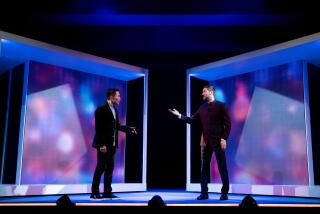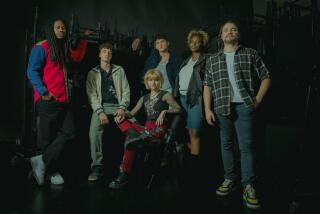Communication evolution
- Share via
Cal State Northridge theater lecturer Doug Kaback was seeking a challenge for his students when he came upon a play for young audiences, “The Taste of Sunrise,” by Susan Zeder. Written from the standpoint of a deaf boy in the 1920s, it dramatized his struggles with that era’s institutional rules against the use of sign language. The deaf, it was felt, should be taught only oral speech.
Kaback’s find led to a first-time partnership between CSUN’s Department of Theater and the Deaf West Theatre, creator of the breakthrough sign-language version of the musical “Big River,” touring nationally after its Mark Taper Forum and Broadway incarnations.
“The Taste of Sunrise” played at CSUN this year. It will also play Friday through Sunday at Deaf West’s 99seat theater in North Hollywood.
Kaback and Deaf West founding member Bob Hiltermann co-directed, collaborating to adapt the play as a dramatic integration of spoken word and sign language.
“Sign language and spoken word are two completely different languages,” said Hilterman, who is hearing-impaired and signs while speaking. “American Sign Language has its own grammar and syntax, so I did multiple work to open it up so that it became a theater art.”
“Having a hearing and a hard-of-hearing director enabled us to explore the nuances in a deeper way,” Kaback said. “We really challenged each other and questioned choices. There was a lot of experimentation with the role of sign-language interpreters, who traditionally just line up along the apron of the stage.”
Instead, Kaback and Hilterman use “shadow actors” as sign interpreters; they perform onstage and embody aspects of the play’s characters.
“What’s most exciting is that what emerges from this play is a kind of evolution of a new culture,” Kaback says. “In a very embryonic way, sign language begins as a subversive language that allows deaf and hard-of-hearing people to communicate.”
The play features deaf, hearing-impaired and hearing student actors. It’s a good fit, Kaback said, for a campus that is home to the National Center on Deafness and a deaf studies program.
Hiltermann hopes the play will lead to other such collaborations. Many plays are staged with deaf and hard-of-hearing actors, he said, “but this is a rare opportunity to do a play about deaf characters.”
-- Lynne Heffley
More to Read
The biggest entertainment stories
Get our big stories about Hollywood, film, television, music, arts, culture and more right in your inbox as soon as they publish.
You may occasionally receive promotional content from the Los Angeles Times.










